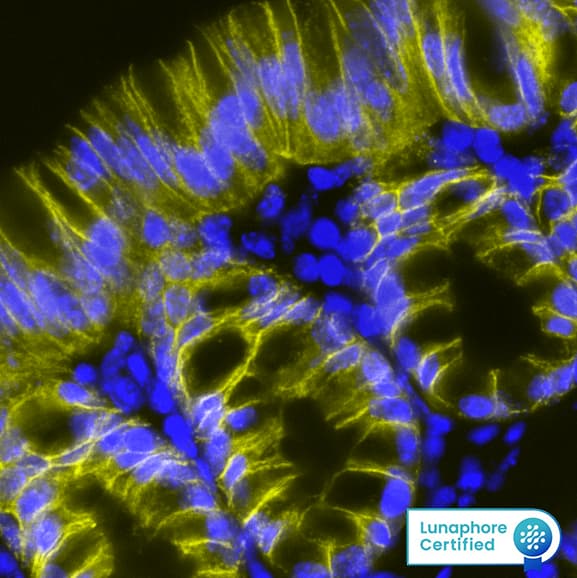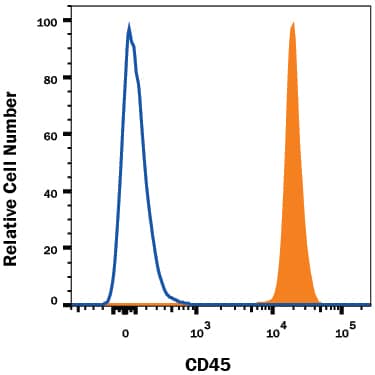Mouse CD45 Antibody Summary
Customers also Viewed
Applications
Please Note: Optimal dilutions should be determined by each laboratory for each application. General Protocols are available in the Technical Information section on our website.
Scientific Data
 View Larger
View Larger
CD45 in Mouse Splenocytes. CD45 was detected in immersion fixed mouse splenocytes (positive staining) and Neuro‑2A mouse neuroblastoma cell line (negative staining) using Rat Anti-Mouse CD45 Monoclonal Antibody (Catalog # MAB114) at 3 µg/mL for 3 hours at room temperature. Cells were stained using the NorthernLights™ 557-conjugated Anti-Rat IgG Secondary Antibody (red; NL013) and counterstained with DAPI (blue). Specific staining was localized to cell surface. Staining was performed using our protocol for Fluorescent ICC Staining of Non-adherent Cells.
 View Larger
View Larger
CD45 in Mouse Spleen. CD45 was detected in immersion fixed paraffin-embedded sections of mouse spleen using Rat Anti-Mouse CD45 Monoclonal Antibody (Catalog # MAB114) at 5 µg/mL for 1 hour at room temperature followed by incubation with the Anti-Rat IgG VisUCyte™ HRP Polymer Antibody (VC005). Before incubation with the primary antibody, tissue was subjected to heat-induced epitope retrieval using Antigen Retrieval Reagent-Basic (CTS013). Tissue was stained using DAB (brown) and counterstained with hematoxylin (blue). Specific staining was localized to cell surface in lymphocytes. Staining was performed using our protocol for IHC Staining with VisUCyte HRP Polymer Detection Reagents.
Preparation and Storage
- 12 months from date of receipt, -20 to -70 °C as supplied.
- 1 month, 2 to 8 °C under sterile conditions after reconstitution.
- 6 months, -20 to -70 °C under sterile conditions after reconstitution.
Background: CD45
CD45, previously called LCA (leukocyte common antigen), T200, or Ly5 in mouse, is member C of the class 1 (receptor-like) protein tyrosine phosphatase family (PTPRC) (1, 2). It is a variably glycosylated 180‑220 kDa transmembrane protein that is abundantly expressed on all nucleated cells of hematopoietic origin (1‑3). CD45 has several isoforms, expressed according to cell type, developmental stage and antigenic exposure (1‑5). The longest form, CD45RABC (called B220 in mouse), is expressed on B lymphocytes (5). The mouse CD45RABC cDNA encodes 1291 amino acids (aa), including a 23 aa signal sequence, a 541 aa extracellular domain containing the splicing region, a cysteine-rich region and two fibronectin type III domains, a 22 aa transmembrane sequence, and a 705 aa cytoplasmic domain that contains two phosphatase domains, D1 and D2. Only D1 has phosphatase activity. CD45R0 is the shortest form, lacking exons 4, 5 and 6 which encode
aa 30‑169. It is expressed on memory cells, while intermediate sizes are expressed on other T cells (3, 4, 6). CD45 has been best studied in T cells, where it determines T cell receptor signaling thresholds (3, 6‑8). CD45 is moved into or out of the immunological synapse (IS) membrane microdomain depending on the relative influence of interaction with the extracellular galectin lattice or the intracellular actin cytoskeleton (9, 10). Galectin interaction can be fine-tuned by varying usage of the heavily O-glycosylated spliced regions and sialylation of N-linked carbohydrates (4, 9). Within the IS, CD45 dephosphorylates and negatively regulates the src family kinase, LCK (8‑10). In other leukocytes, CD45 influences differentiation and links immunoreceptor signaling with cytokine secretion and cell survival, partially overlapping in function with DEP-1/CD148 (11‑14). CD45 deletion causes in severe immunodeficiency, while point mutations may be associated with autoimmune disorders (6, 7).
- Anderson, J.N. et al. (2004) FASEB J. 18:8.
- Streuli, M. et al. (1987) J. Exp. Med. 166:1548.
- Hermiston, M.L. et al. (2003) Annu. Rev. Immunol. 21:107.
- Earl, L.A. and L.G. Baum (2008) Immunol. Cell Biol. 86:608.
- Ralph, S.J. et al. (1987) EMBO J. 6:1251.
- Falahti, R. and D. Leitenberg (2008) J. Immunol. 181:6082.
- Tchilian, E.Z. and P.C.L. Beverley (2006) Trends Immunol. 27:146.
- McNiell, L. et al. (2007) Immunity 27:425.
- Chen, I-J. et al. (2007) J. Biol. Chem. 282:35361.
- Freiberg, B.A. et al. (2002) Nat. Immunol. 3:911.
- Zhu, J.W. et al. (2008) Immunity 28:183.
- Huntington, N.D. et al. (2006) Nat. Immunol. 7:190.
- Hesslein, D.G. et al. (2006) Proc. Natl. Acad. Sci. USA 103:7012.
- Cross, J.L. et al. (2008) J. Immunol. 180:8020.
- Ledbetter, J.A. and L.A. Herzenberg (1979) Immunol. Rev. 47:63.
Product Datasheets
Citations for Mouse CD45 Antibody
R&D Systems personnel manually curate a database that contains references using R&D Systems products. The data collected includes not only links to publications in PubMed, but also provides information about sample types, species, and experimental conditions.
24
Citations: Showing 1 - 10
Filter your results:
Filter by:
-
CD4+ T cells are activated in regional lymph nodes and migrate to skin to initiate lymphedema
Authors: GD García Nor, CL Ly, DA Cuzzone, RP Kataru, GE Hespe, JS Torrisi, JJ Huang, JC Gardenier, IL Savetsky, MD Nitti, JZ Yu, S Rehal, BJ Mehrara
Nat Commun, 2018-05-17;9(1):1970.
-
The extracellular matrix of lymph node reticular fibers modulates follicle border interactions and germinal center formation
Authors: Jian Song, Tushar Deshpande, Xueli Zhang, Melanie-Jane Hannocks, Nils Lycke, Susanna L. Cardell et al.
iScience
-
Dual targeting of mTOR/IL-17A and autophagy by fisetin alleviates psoriasis-like skin inflammation
Authors: Tithi Roy, Sergette Banang-Mbeumi, Samuel T. Boateng, Emmanuelle M. Ruiz, Roxane-Cherille N. Chamcheu, Lin Kang et al.
Frontiers in Immunology
-
TGF‐ beta 1 mediates pathologic changes of secondary lymphedema by promoting fibrosis and inflammation
Authors: Jung Eun Baik, Hyeung Ju Park, Raghu P. Kataru, Ira L. Savetsky, Catherine L. Ly, Jinyeon Shin et al.
Clinical and Translational Medicine
-
TnP Peptide Suppresses Experimental Autoimmune Encephalomyelitis (EAE) in a Preclinical Mouse Model
Authors: Carla Lima, Adolfo Luis Almeida Maleski, Jefferson Thiago Gonçalves Bernardo, Vitor Cataldi Zelli, Evilin Naname Komegae, Monica Lopes-Ferreira
Frontiers in Immunology
-
Rubicon-regulated beta-1 adrenergic receptor recycling protects the heart from pressure overload
Authors: Y Akazawa, M Taneike, H Ueda, R Kitazume-T, T Murakawa, R Sugihara, H Yorifuji, H Nishida, K Mine, A Hioki, S Omiya, H Nakayama, O Yamaguchi, T Yoshimori, Y Sakata, K Otsu
Scientific Reports, 2022-01-07;12(1):41.
Species: Mouse
Sample Types: Whole Tissue
Applications: IHC -
Fasting and fasting-mimicking treatment activate SIRT1/LXR alpha and alleviate diabetes-induced systemic and microvascular dysfunction
Authors: Sandra S. Hammer, Cristiano P. Vieira, Delaney McFarland, Maximilian Sandler, Yan Levitsky, Tim F. Dorweiler et al.
Diabetologia
-
Impact of Preanalytical Factors During Histology Processing on Section Suitability for Digital Image Analysis
Authors: Elizabeth A. Chlipala, Mark Butters, Miles Brous, Jessica S. Fortin, Roni Archuletta, Karen Copeland et al.
Toxicologic Pathology
-
Deficiency in Aim2 affects viability and calcification of vascular smooth muscle cells from murine aortas and angiotensin-II induced aortic aneurysms
Authors: Markus Wortmann, Muhammad Arshad, Maani Hakimi, Dittmar Böckler, Susanne Dihlmann
Molecular Medicine
-
Deficiency of peroxiredoxin 2 exacerbates angiotensin II-induced abdominal aortic aneurysm
Authors: SJ Jeong, MJ Cho, NY Ko, S Kim, IH Jung, JK Min, SH Lee, JG Park, GT Oh
Exp. Mol. Med., 2020-09-14;0(0):.
Species: Human, Mouse
Sample Types: Whole Tissue
Applications: IHC -
Cytokine mRNA Degradation in Cardiomyocytes Restrains Sterile Inflammation in Pressure-Overloaded Hearts
Authors: Shigemiki Omiya, Yosuke Omori, Manabu Taneike, Tomokazu Murakawa, Jumpei Ito, Yohei Tanada et al.
Circulation
-
Tumor Lymphatic Function Regulates Tumor Inflammatory and Immunosuppressive Microenvironments
Authors: Raghu P. Kataru, Catherine L. Ly, Jinyeon Shin, Hyeung Ju Park, Jung Eun Baik, Sonia Rehal et al.
Cancer Immunology Research
-
T helper 2 differentiation is necessary for development of lymphedema
Authors: Catherine L. Ly, Gabriela D. García García Nores, Raghu P. Kataru, Babak J. Mehrara
Translational Research
-
UHRF1 epigenetically orchestrates smooth muscle cell plasticity in arterial disease
Authors: L Elia, P Kunderfran, P Carullo, M Vacchiano, FM Farina, IF Hall, S Mantero, C Panico, R Papait, G Condorelli, M Quintavall
J. Clin. Invest., 2018-05-07;0(0):.
Species: Mouse
Sample Types: Whole Tissue
Applications: IHC -
Combination of CD40 agonism and CSF-1R blockade reconditions tumor-associated macrophages and drives potent antitumor immunity
Authors: KR Wiehagen, NM Girgis, DH Yamada, AA Smith, SR Chan, IS Grewal, M Quigley, RI Verona
Cancer Immunol Res, 2017-11-02;0(0):.
Species: Mouse
Sample Types: Whole Cells
Applications: Flow Cytometry -
Multiple functional therapeutic effects of TnP: A small stable synthetic peptide derived from fish venom in a mouse model of multiple sclerosis
Authors: EN Komegae, TA Souza, LZ Grund, C Lima, M Lopes-Ferr
PLoS ONE, 2017-02-24;12(2):e0171796.
Species: Mouse
Sample Types: Whole Cells
Applications: Flow Cytometry -
Growth inhibition of formed corneal neovascularization following Fosaprepitant treatment
Authors: F Bignami, A Lorusso, P Rama, G Ferrari
Acta Ophthalmol, 2017-02-15;0(0):.
Species: Mouse
Sample Types: Whole Tissue
Applications: IHC -
Toll-like receptor 9 prevents cardiac rupture after myocardial infarction in mice independently of inflammation
Authors: Shigemiki Omiya, Yosuke Omori, Manabu Taneike, Andrea Protti, Osamu Yamaguchi, Shizuo Akira et al.
American Journal of Physiology-Heart and Circulatory Physiology
-
Diphtheria toxin–mediated ablation of lymphatic endothelial cells results in progressive lymphedema
Authors: Jason C. Gardenier, Geoffrey E. Hespe, Raghu P. Kataru, Ira L. Savetsky, Jeremy S. Torrisi, Gabriela D. García Nores et al.
JCI Insight
-
Induction of KIAA1199/CEMIP is associated with colon cancer phenotype and poor patient survival
Authors: Stephen P. Fink, Lois L. Myeroff, Revital Kariv, Petra Platzer, Baozhong Xin, Debra Mikkola et al.
Oncotarget
-
A GRHL3-regulated repair pathway suppresses immune-mediated epidermal hyperplasia
Authors: William M. Gordon, Michael D. Zeller, Rachel H. Klein, William R. Swindell, Hsiang Ho, Francisco Espetia et al.
Journal of Clinical Investigation
-
Nucleosomes contribute to increase mesangial cell chemokine expression during the development of lupus nephritis.
Authors: Kanapathippillai P, Hedberg A, Fenton C, Fenton K
Cytokine, 2013-04-04;62(2):244-52.
Species: Mouse
Sample Types: Whole Tissue
Applications: IHC -
Extracellular adenosine signaling induces CX3CL1 expression in the brain to promote experimental autoimmune encephalomyelitis.
J Neuroinflammation, 2012-08-10;9(0):193.
Species: Mouse
Sample Types: Whole Tissue
Applications: IHC-Fr -
Long-term effects of polymer-based, slow-release, sirolimus-eluting stents in a porcine coronary model.
Authors: Carter AJ, Aggarwal M, Kopia GA, Tio F, Tsao PS, Kolata R, Yeung AC, Llanos G, Dooley J, Falotico R
Cardiovasc. Res., 2004-09-01;63(4):617-24.
Species: Porcine
Sample Types: Tissue Homogenates
Applications: Western Blot
FAQs
No product specific FAQs exist for this product, however you may
View all Antibody FAQsReviews for Mouse CD45 Antibody
There are currently no reviews for this product. Be the first to review Mouse CD45 Antibody and earn rewards!
Have you used Mouse CD45 Antibody?
Submit a review and receive an Amazon gift card.
$25/€18/£15/$25CAN/¥75 Yuan/¥2500 Yen for a review with an image
$10/€7/£6/$10 CAD/¥70 Yuan/¥1110 Yen for a review without an image
























